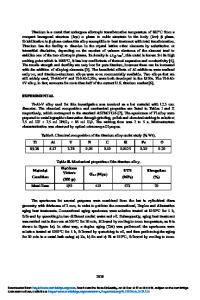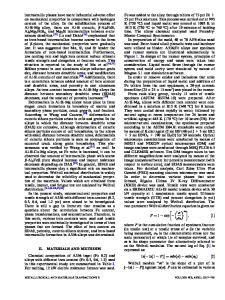The effect of aging on the mechanical properties of a nickel-molybdenum-iron alloy (hastelloy B)
- PDF / 1,204,968 Bytes
- 3 Pages / 612 x 792 pts (letter) Page_size
- 72 Downloads / 312 Views
FRANK
ROAN
A N D C. R. B R O O K S
N i c k e l - m o l y b d e n u m alloys c o n t a i n i n g a p p r o x i m a t e l y 29 wt pct Mo a r e d i s o r d e r e d , fcc solid s o l u t i o n s (~ phase) above a p p r o x i m a t e l y 868~ but o r d e r below this t e m p e r a t u r e , ~ or, for m o l y b d e n u m c o n t e n t s l e s s than the s t o i c h i o m e t r i c Ni4Mo , p r e c i p i t a t e the o r d e r e d phase (/3). ~ Both the o r d e r i n g and the p r e c i p i t a t i o n induce c o n s i d e r a b l e s t r e n g t h e n i n g z's but e m b r i t t l e the m a t e r i a l , with f r a c t u r e o c c u r r i n g along the f o r m e r a g r a i n b o u n d a r i e s . However, the c o m m e r c i a l alloy Hastelloy B, which c o n t a i n s a p p r o x i m a t e l y 28 wt pct Mo, shows c o n s i d e r a b l e s t r e n g t h e n i n g on aging but no s i g n i f i c a n t e m b r i t t l e m e n t . The d i f f e r e n c e in b e h a v i o r s e e m s to be due to the p r e s e n c e of about 5 pct Fe, which either r e t a r d s the f o r m a t i o n of the o r d e r e d / 3 phase, or p l a c e s
the ternary alloy outside the phase boundaries of/3 formation. We report here extensive mechanical properties of Hastelloy B measured from 25 to 870~ for the solution-annealed condition, and properties at 25~ as a function of aging time (up to 1200 h) from 705 to 900~ These measurements, together with those in the literature, give a quite complete picture of the tensile mechanical property behavior of this alloy. Preliminary observations of the microstructures developed d u r i n g the aging also a r e p r e s e n t e d . The m a t e r i a l r e c e i v e d f r o m the m a n u f a c t u r e r (Cabot Corporation) was hot wrought plate about 0.9 cm thick. T h e c h e m i c a l a n a l y s i s was (wt pct) 65.05 pet Ni, 26.80 pct Mo, 5.30 pct Fe, 0.32 pct Co, 0.34 pct Si, 0.53 pct Mn 0.43 pct Cr, 0.28 pct V, and 0.02 pct C. T e n s i l e b a r s with 2.54 cm gage length and a 0.317 cm d i a m e t e r w e r e m a c h i n e d f r o m the plate. M e t a l l o g r a p h i c s a m p l e s were a p p r o x i m a t e l y 0.9• 0.9 • 4 cm. All s p e c i m e n s w e r e s e a l e d in q u a r t z tubes evacuated to a p p r o x i m a g e l y 100 # m of Hg, s o l u t i o n - a n n e a l e d at 1150~ (• 10~ for 2 h, then cooled in the q u a r t z tubes to 25~ Samples were aged in evacuated q u a r t z tubes from 705 to 900~ (•176 for up to 1200 h. Metallographic s p e c i m e n s were etched by i m m e r s i o n for 25 s in a s o l u t i o n of 0.002 Kg CrO3, 40 c m 3 HC1 and 80 cm s H20. T e n s i l e t e s t s were made u s i n g an I n s t r o n m a c h i n e . A c l o s e d - c e l l f u r n a c e was used for t e s t i n g at elevated t e m p e r a t u r e in a i r . In all c a s e s the s t r a i n r a t e as given by the c r o s s - h e a d m o v e m e n t was 0.127 c m m i n -~. Duplicate t e s t s w e r e m a d e only at 25~ for the solution a n n e a l e d condition; the d e r i v e d p r o p e r t i e
Data Loading...











